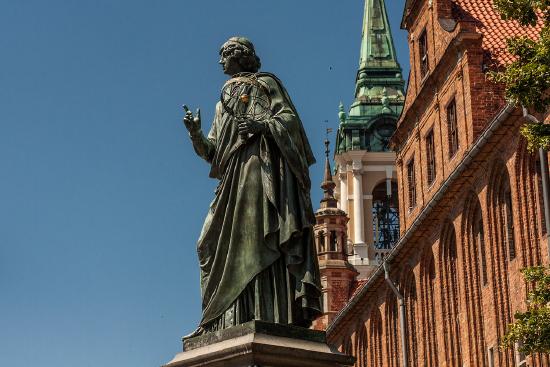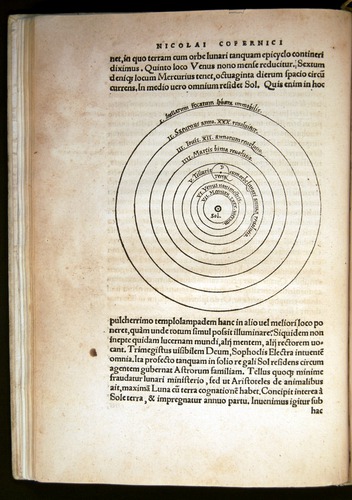3.1: Nicholas Copernicus (1473-1543)- The Quiet Revolutionary
- Page ID
- 30866
 "Copernicus" by c.darek is licensed under CC BY-SA 2.0;
"Copernicus" by c.darek is licensed under CC BY-SA 2.0; Nicholas Copernicus was born the youngers of four children in Torun, Poland. He studied mathematics and astronomy in Krakow and then medicine in Padua, Italy. After completing his studies, her returned home to the Prince-Bishopric of Warmia in Prussia (Poland) where he assumed several duties for the diocese. Eventually, he settled in Frauenburg and took charge of the bishopric’s financial enterprises, including acting as sort of the landlord for the various tenant farmers living and working on church owned land. He also continued to practice medicine, but his true passion remained mathematics and astronomy.
Like many of his contemporaries, Copernicus noted the errors in Ptolemy’s predictions and its failure to explain Mars’ change in brightness. Soon, he realized that he could simplify the mathematics of planetary motion by putting the Sun at the center instead of the Earth. Following the principle of Occam’s razor, in which the simplest explanation with the fewest unnecessary complications, is the better answer, Copernicus became convinced of the correctness of heliocentrism. Putting the Sun at the center also explained the change in brightness and retrograde motion of Mars. Mars and Earth both orbit the Sun, but Earth, being closer in, has a shorter path and moves faster than Mars. As a result, Mars appears to move backwards whenever Earth overtakes it in its orbit. Mars’ brightness also changes because, as the planets orbit the Sun, their relative distance to one another changes. Mars therefore appears brighter when it is closer to the Earth and dimmer when they are further apart.
Despite his confidence in his theory, Copernicus was reluctant to publish. He feared not only church authorities but also ridicule from fellow astronomers. While his model better explained retrograde motion and changes in brightness, he could explain the lack of parallax among the fixed stars. Also, he still assumed the planets moved in perfect circles and could not make better predictions than Ptolemy’s models. Also, most natural philosophers of his time argued that if the Earth moved, birds would fly backwards, and church steeples would topple as they resisted the motion.
Finally, his friends convinced Nicholas to publish. He received permission from a friendly bishop to publish and dedicated his work, De Revolutionibus Orbium Coelestium (On the Revolutions of the Celestial Spheres), to the Pope. He had hoped that these actions would insulate him from any charges of heresy. However, just as the printers were preparing his book, Nicholas Copernicus died in 1543 at the age of seventy. He, therefore, avoided the ridicule and censure he had feared in life. However, the authorities did not look kindly on his work and eventually put his book the Index of Forbidden Works.
 Excerpt from Copernicus' treatise on planetary motion.
Excerpt from Copernicus' treatise on planetary motion.
Nicolaus Copernicu, De revolutionibus orbium coelestium (Norimbergae, 1543).

